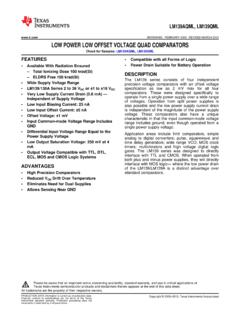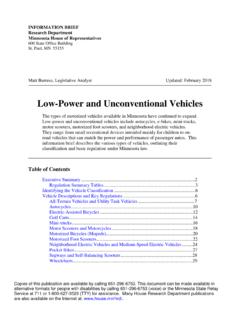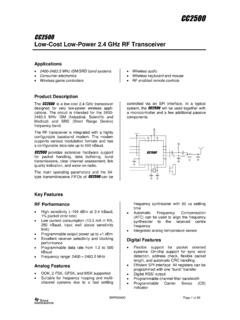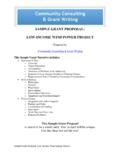Transcription of PIC Microcontroller Low Power Tips ‘n Tricks …
1 PIC Microcontroller Low Power tips n Tricks CHAPTER 2. PIC Microcontroller Low Power tips n Tricks Table Of Contents tips N Tricks INTRODUCTION. Microchip continues to provide innovative products that are smaller, faster, easier to GENERAL LOW Power tips N Tricks . use and more reliable. The Flash-based PIC . TIP #1 Switching Off External Circuits/ microcontrollers (MCUs) are used in an wide Duty 2-2. range of everyday products, from smoke TIP #2 Power 2-3 detectors, hospital ID tags and pet containment TIP #3 Configuring Port 2-4 systems, to industrial, automotive and medical TIP #4 Use High-Value Pull-Up 2-4 products.
2 TIP #5 Reduce Operating 2-4. TIP #6 Use an External Source for PIC MCUs featuring nanoWatt technology CPU Core 2-5 implement a variety of important features which TIP #7 Battery Backup for PIC MCUs .. 2-6 have become standard in PIC microcontrollers . Since the release of nanoWatt technology, DYNAMIC OPERATION tips N Tricks changes in MCU process technology and TIP #8 Enhanced PIC16 Mid-Range 2-6 improvements in performance have resulted in TIP #9 Two-Speed 2-7 new requirements for lower Power . PIC MCUs TIP #10 Clock 2-7 with nanoWatt eXtreme Low Power (nanoWatt TIP #11 Use Internal RC 2-7 XLP ) improve upon the original nanoWatt TIP #12 Internal Oscillator 2-8 technology by dramatically reducing static TIP #13 Idle and Doze 2-8 Power consumption and providing new flexibility TIP #14 Use NOP and Idle 2-9 for dynamic Power management.
3 TIP #15 Peripheral Module Disable The following series of tips n' Tricks can be (PMD) 2-9. applied to many applications to make the most STATIC Power REDUCTION tips N Tricks of PIC MCU nanoWatt and nanoWatt XLP. TIP #16 Deep Sleep 2-10 devices. TIP #17 Extended WDT and Deep Sleep 2-10 GENERAL LOW Power tips N. TIP #18 Low Power Timer1 Oscillator Tricks . and 2-10. TIP #19 Low Power Timer1 Oscillator 2-11 The following tips can be used with all PIC. TIP #20 Use LVD to Detect Low 2-11 MCUs to reduce the Power consumption of TIP #21 Use Peripheral FIFO and 2-11 almost any application. TIP #22 Ultra Low- Power Wake-Up 2-12.
4 2009 Microchip Technology Inc. DS01146B-Page 2-1. PIC Microcontroller Low Power tips n Tricks TIP #1 Switching Off External Example: Circuits/Duty Cycle The application is a long duration data recorder. All the low Power modes in the world won't help It has a sensor, an EEPROM, a battery and a your application if you are unable to control microprocessor. Every two seconds, it must the Power used by circuits external to the take a sensor reading, scale the sensor data, microprocessor. Lighting an LED is equivalent store the scaled data in EEPROM and wait for to running most PIC MCUs at 5V-20 MHz. the next sensor reading.
5 When you are designing your circuitry, decide what physical modes or states are required and partition the electronics to shutdown unneeded circuitry. Figure: 1-1. C2. F. U1. VDD. 100k R2. R4. 10k 10k R5. MCLR. RA0 RB0/INT. U2. R3. RA1 RB1 VCC A0. 1k RA2 RB2 WP A1. F. C1. RA3 RB3 SCL A2. RA4/TOCKI RB4 SDA GND. RB5. Serial EEPROM. OSC1/CLKIN RB6 Y1. 22 pF. R1 OSC2/CLKOUT RB7. C3. 100k VSS kHz 33 pF. 33 pF. C5. C4. PIC16F819. The system shown above is very simple In Figure 1-2, I/O pins are used to Power the and clearly has all the parts identified in the EEPROM and the sensor. Many PIC MCU. requirements. Unfortunately, it has a few devices can source up to 20 mA of current problems in that the EEPROM, the sensor, and from each I/O, so there is no need to provide its bias circuit, are energized all the time.
6 To additional components to switch the Power . get the minimum current draw for this design, If more current than can be sourced by the PIC. it would be advantageous to shutdown these MCU is required, the PIC MCU can instead circuits when they are not required. enable and disable a MOSFET to Power Figure: 1-2 the circuit. Refer to the data sheet for drive capabilities for a specific device. C2. F. U1. VDD. 100k R5. R4. 10k R2. 10k MCLR. RA0 RB0/INT. U2. R3. RA1 RB1 VCC A0. 1k RA2 RB2 WP A1. F. C1. RA3 RB3 SCL A2. RA4/TOCKI RB4 SDA GND. RB5. Serial EEPROM. OSC1/CLKIN RB6 Y1. 22 pF. R1 OSC2/CLKOUT RB7. C3. 100k VSS kHz 33 pF.
7 33 pF. C5. C4. PIC16F819. Page 2-2-DS01146B 2009 Microchip Technology Inc. PIC Microcontroller Low Power tips n Tricks TIP #2 Power Budgeting Computing Battery Life Power budgeting is a technique that is critical to Using the average current from the calculated predicting current consumption and battery life. Power budget, it is possible to determine Power budgeting is performed by calculating how long a battery will be able to Power the the total charge for each mode of operation application. Table 2 shows lifetimes for typical of an application by multiplying that mode's battery types using the average Power from current consumption by the time in the mode Table 1.
8 For a single application loop. The charge for Life each mode is added, then averaged over the Battery Capacity (mAh). total loop time to get average current. Table 1 Hours Days Months Years calculates a Power budget using the application CR1212 18 4180 174 .48. from Figure 2 in Tip #1 using a typical nanoWatt CR1620 75 17417 726 XLP device. CR2032 220 51089 2129 Time Current (mA) Charge Alkaline AAA 1250 290276 12095 in Current *. Mode By Mode Alkaline AA 2890 671118 27963 Mode Time (mS) Device Total (mA * Sec) Li-ion* 850 197388 8224 Sleep NOTE: Calculations are based on average current draw only and MCU Sleep do not include battery self-discharge.
9 Sensor Off 1989 0 EEPROM Off 0 *Varies by size; value used is typical. Initialize MCU Sleep After completing a Power budget, it is very easy Sensor On 1 to determine the battery size required to meet EEPROM Off 0 the application requirements. If too much Power Sample Sensor is consumed, it is simple to determine where MCU Run Sensor On 1 additional effort needs to be placed to reduce EEPROM Off 0 the Power consumption. Scaling MCU Run Sensor Off 1 0 EEPROM Off 0. Storing MCU Run Sensor Off 8 0 +00 EEPROM On 1. Total 2000 Average Current = mA*Sec 2000e-3 Sec = mA. Peak Current mA. 2009 Microchip Technology Inc. DS01146B-Page 2-3.
10 PIC Microcontroller Low Power tips n Tricks TIP #3 Configuring Port Pins TIP #4 Use High-Value Pull-Up All PIC MCUs have bidirectional I/O pins. Some Resistors of these pins have analog input capabilities. It It is more Power efficient to use larger pull-up is very important to pay attention to the signals resistors on I/O pins such as MCLR, I2C . applied to these pins so the least amount of signals, switches and for resistor dividers. For Power will be consumed. example, a typical I2C pull-up is However, Unused Port Pins when the I2C is transmitting and pulling a line low, this consumes nearly 700 uA of current for If a port pin is unused, it may be left each bus at By increasing the size of the unconnected but configured as an output pin I2C pull-ups to 10k, this current can be halved.















